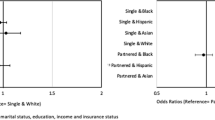Abstract
Purpose
To evaluate the quality of maternity care, women’s perception of the quality of care and factors influencing the same in Delhi.
Method
Women who delivered a viable live birth in the past 6 months were recruited from South Delhi by a two-stage stratified cluster randomized sampling. In stage 1, two colonies each from three predefined economic strata (high-, middle- or low-income areas) were selected by simple-random sampling. In stage 2, a sequential house-to-house survey was conducted in each selected colony. The information was collected by interview and review of medical records.
Results
A total of 5,279 houses were screened to recruit 249 subjects. Several disparities were notable. 25.2 and 14.8% of the women from middle- and lower-income areas delivered by cesarean section, while the rate was 53.6% in the higher-income areas. In women from lower-income areas urine testing was not done in 76.9% and blood sugar was not tested in 18.2%, while in high-income areas 44.6% had ≥10 antenatal visits and 87.8% had ≥3 ultrasounds. Of the women who experienced labor only 11% received support from a friend or family member, 4.4% received any medicine/measures for pain relief, 44.3% were allowed to walk and 14.6% were catheterized.
Conclusion
Health care providers are unable to meet national minimal care standards in poorer areas, while over investigation and over intervention appear prevalent in higher-income areas. This warrants a more representative evaluation to enable more equitable and evidence-based practice.


Similar content being viewed by others
References
Steffen GE (1988) Quality medical care. A definition. JAMA 260:56–61
Institute of Medicine, Committee to Design a Strategy for Quality Review and Assurance in Medicine (1990) In: Lohr KN (ed) Medicare: a strategy for quality assurance/Committee to Design a Strategy for Quality Review and Assurance in Medicare, Division of Health Care Services, Institute of Medicine. Report of a study, vol 1. National Academy Press, Washington, DC, p 468
Choudhry MTM (2005) Maternal mortality and quality of maternity care: implications for Pakistan. Thesis for degree of master in health promotion. http://openmed.nic.in/1370/01/My_Thesis.pdf
Proctor S (1998) What determines quality in maternity care? Comparing the perceptions of childbearing women and midwives. Birth 25(2):85–93
Hundley V, Penney G, Fitzmaurice A, van Teijlingen E, Graham W (2002) A comparison of data obtained from service providers and service users to assess the quality of maternity care. Midwifery 18(2):126–135
Sakala C, Corry MP (2007) Listening to Mothers II reveals maternity care quality chasm. J Midwifery Womens Health 52:183–185
National Family Health Survey (NFHS)-2 India, Main Report. http://www.nfhsindia.org/data/india/indch9.pdf. Accessed 30 Jun 2007
Report on the District Level Household Survey 2002–2004. http://www.rchindia.org/dlhs_india.htm. Accessed 05 Jul 2007
Reproductive and Child Health Program. http://www.rchindia.org/. Accessed 5 Jul 2007
Dhar Sengupta R, Nagpal J, Sinha S, Bhargava VL, Sachdeva A, Bhartia A (2009) Direct cost of maternity care services in South Delhi: a community survey. J Health Popul Nutr 27(3):368–378
Nagpal J, Dhar Sengupta R, Sinha S, Bhargava VL, Sachdeva A, Bhartia A (2008) An exploratory study to evaluate the utility of an adapted Mother Generated Index (MGI) in assessment of postpartum quality of life in India. Health Qual Life Outcomes 6:107
National Family Health Survey (NFHS)-3 India. http://www.nfhsindia.org/nfhs3.html. Accessed 12 Jan 2008
Listening to mother’s survey, questionnaire. http://www.childbirthconnection.com/pdf.asp?PDFDownload=LtMquestionnaire. Accessed 12 Jan 2008
A guide to monitoring and evaluating adolescent reproductive health programs. Part I: The how-to’s of monitoring and evaluation. Appendix 2: How to calculate sample size requirements. http://www.fhi.org/NR/rdonlyres/e3h3wstdemc5e4gxbthsmvs2swl7a23uj7kbdscinx7swrivgvs2el75xu4kktbfr7mlzqstkxa6ra/Appendices24.pdf. Accessed 16 Jun 2009
Idanpaan-Heikkila UM, Lambie L, Mattke S et al (2006) Selecting indicators for the quality of cardiac care at the health system level in Organization for Economic Co-operation and Development countries. Int J Qual Health Care 18:39–44
National Diabetes Quality Improvement Alliance Performance measure set for adult diabetes. http://www.nationaldiabetesalliance.org/Final2005Measures.pdf. Accessed 20 May 2006
Intrapartum care: care of healthy women and their babies during childbirth. NICE guideline (2006). http://www.nice.org.uk/page.aspx?o=334322. Accessed 23 Aug 2007
National Population Policy (2000) http://www.whoindia.org/LinkFiles/Policy_Population-Policy.pdf. Accessed 5 Jul 2007
World Health Organization (1985) Appropriate technology for birth. Lancet 2:436–437
Indian Council of Medical Research (1990) Collaborative study on high risk pregnancies and maternal mortality (ICMR task force study). ICMR, New Delhi
Sreevidya S, Sathiyasekaran BWC (2003) High caesarean rates in Madras (India): a population-based cross-sectional study. BJOG 110:106–111
Mishra US, Mala R (2002) Delivery-related complications and determinants of caesarean section rates in India. Health Policy Plan 17(1):90–99
Guidelines for Perinatal Care. American Academy of Pediatrics and American College of Obstetrics and Gynecology, 5th edn. http://www.acog.org/bookstore/Guidelines_for_Perinatal_Care__P262C54.cfm. Accessed 12 Aug 2007
Hundley V, Rennie AM, Fitzmaurice A et al (2000) A national survey of women’s views of their maternity care in Scotland. Midwifery 16:303–313
Cesarean section: Clinical guideline (2004) National Collaborating Center for Women’s and Children’s Health. http://guidance.nice.org.uk/CG13/guidance/pdf/English. Accessed 30 Jul 2007
Annual Report of the Ministry of Health and Family Welfare (2006–2007) http://mohfw.nic.in/annualrep%20english/Contents.pdf. Accessed 12 Jan 2008
Bruce J (1990) Fundamental elements of the quality of care: a simple framework. Stud Fam Plann 21:61–91
Lothian JA (2003) Listening to mothers—the first national U.S. survey of women’s childbearing experiences. J Perinat Educ 12:vi–viii
Qian X, Smith H, Liang H et al (2006) Evidence-informed obstetric practice during normal birth in China: trends and influences in four hospitals. BMC Health Serv Res 6:29
Hildingsson I, Thomas JE (2007) Women’s perspectives on maternity services in Sweden: processes, problems, and solutions. J Midwifery Womens Health 52:126–133
Acknowledgments
We are indebted to the research teams for their efforts. The study was supported by intramural funding from Sitaram Bhartia Institute of Science and Research. Approved by the Institutional Ethics Committee (No. 04/2007, Dated 9/9/2007)
Conflict of interest statement
None.
Author information
Authors and Affiliations
Corresponding author
Rights and permissions
About this article
Cite this article
Dhar , R.S., Nagpal, J., Bhargava, V. et al. Quality of care, maternal attitude and common physician practices across the socio-economic spectrum: a community survey. Arch Gynecol Obstet 282, 245–254 (2010). https://doi.org/10.1007/s00404-009-1214-x
Received:
Accepted:
Published:
Issue Date:
DOI: https://doi.org/10.1007/s00404-009-1214-x




